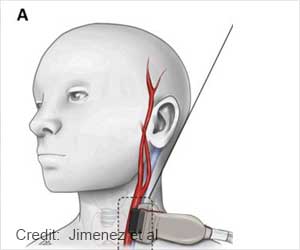Implementing new hypertension guidelines fully can prevent 56,000 cardiovascular disease events like heart attacks and strokes and 13,000 deaths each year, found in an analysis of data.

"Our findings clearly show that it would be worthwhile to significantly increase spending on office visits, home blood pressure monitoring, and interventions to improve treatment adherence," said lead author Andrew E. Moran, MD, MPH, the Herbert Irving Assistant Professor of Medicine at CUMC and a physician at NewYork-Presbyterian/Columbia. "In fact, we could double treatment and monitoring spending for some patients-namely those with severe hypertension-and still break even."
Earlier this year, an expert panel originally appointed by the National Heart, Lung and Blood Institute released new, simplified guidelines for the treatment of high blood pressure. The 2014 guidelines are less aggressive for some patients, shifting treatment targets to higher blood pressures. Fewer patients need treatment under the new guidelines, but according to Dr. Moran, "even with the more relaxed goals, an estimated 44 percent of adults with hypertension, or 28 million people, still do not have their blood pressure adequately controlled."
To evaluate the impact and cost-effectiveness of implementing the new guidelines, the CUMC team ran a computer simulation-accounting for cost of treatment, savings from reductions in cardiovascular disease (CVD) treatment, and quality-of-life gains-for U.S. adults ages 35 to 74 from 2014 to 2024.
"Given rising health care costs and limited budgets, it's important to determine the cost-effectiveness of implementing the new guidelines and whether we should focus on specific patient subgroups," said study leader Lee Goldman, MD, MPH, Harold and Margaret Hatch Professor of the University and dean of the faculties of health sciences and medicine at CUMC.
The researchers found that full implementation of the new guidelines would save costs by reducing mortality and morbidity related to CVD. The cost savings were largely driven by favorable results from secondary prevention (measures taken after disease is diagnosed) in patients with CVD and primary prevention (measures taken to prevent disease) in those with stage 2, or severe, hypertension (defined below). Treating stage 1 hypertension was cost-effective in all men and women ages 45 to 74.
Advertisement
The study did not look at the cost-effectiveness of hypertension treatment in adults over the age of 74. The CUMC team is addressing this question in a separate study.
Advertisement
Stage 1 hypertension is defined as a systolic BP of 140-159 mm Hg or a diastolic BP of 90-99 mm Hg. Stage 2, or severe, hypertension is a systolic BP of 160 mmHg or higher or a diastolic BP of 100 mmHg or higher.
The article is titled, "Cost-effectiveness of hypertension treatment according to 2014 guidelines." The other contributors are: Michelle C. Odden, PhD (Oregon State University, Corvallis, OR); Anusorn Thanataveerat, MPH (CUMC); Keane Y. Tzong, MPH (CUMC); Petra W. Rasmussen, MPH (CUMC); David Guzman, MSPH (San Francisco General Hospital, San Francisco, CA); Lawrence Williams, MS (Partners Health Care, Boston, MA); Kirsten Bibbins-Domingo, MD, PhD (San Francisco General Hospital); and Pamela G. Coxson, PhD (San Francisco General Hospital).
The authors declare no financial or other conflicts of interest.
The study was funded by a grant from the National Heart, Lung, and Blood Institute Award (R01 HL107475-01), an American Heart Association Founder's Affiliate Clinical Research Program Award (10CRP4140089), a Columbia University Irving scholarship, and a U.S. National Institute for Neurological Disorders and Stroke Award (U54NS081760).
Columbia University Medical Center provides international leadership in basic, preclinical, and clinical research; medical and health sciences education; and patient care. The medical center trains future leaders and includes the dedicated work of many physicians, scientists, public health professionals, dentists, and nurses at the College of Physicians and Surgeons, the Mailman School of Public Health, the College of Dental Medicine, the School of Nursing, the biomedical departments of the Graduate School of Arts and Sciences, and allied research centers and institutions. Columbia University Medical Center is home to the largest medical research enterprise in New York City and State and one of the largest faculty medical practices in the Northeast.
Source-Newswise















